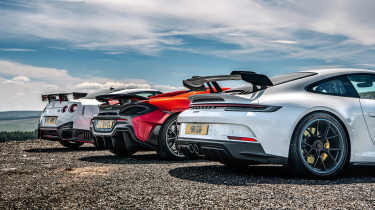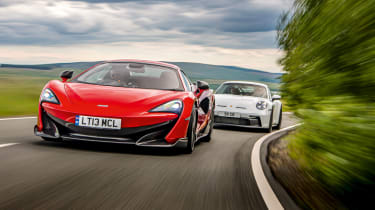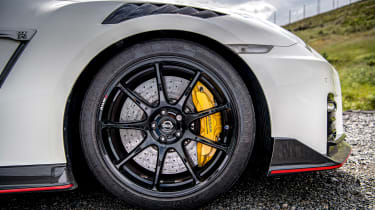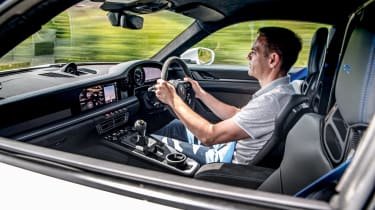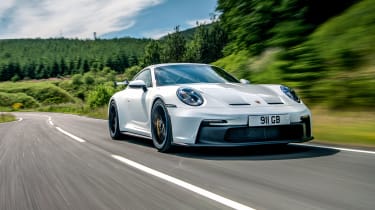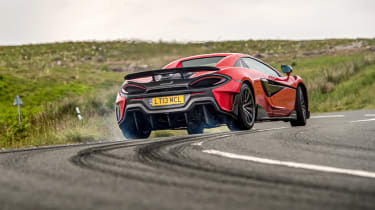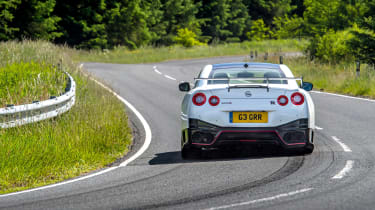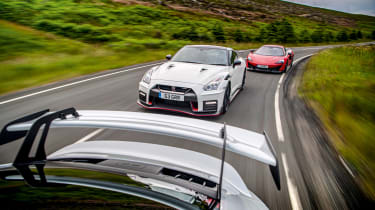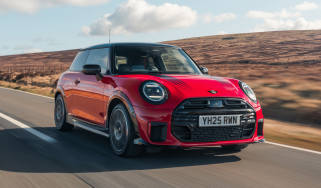McLaren 600LT v Porsche 911 GT3 v Nissan GT-R Nismo
What will it take to expose any weaknesses in the new 911 GT3? Nissan’s brutal GT-R Nismo and McLaren’s ballistic 600LT should have the power and polish to reveal any flaws
How do you beat the Porsche 911 GT3? As I point the jutting splitter of a McLaren 600LT northwards towards The Borders and the sinewy, weather-ravaged roads that criss-cross between England and Scotland, I sense this is a question not just for the next couple of days, but one that occupies the minds of engineers and test drivers the world over on a constant loop.
As I glide in the svelte McLaren, John Barker is muscling his way to our rendezvous in the Nissan GT-R Nismo. The angular Japanese coupe, built to a different scale and resembling a 1960s brutalist block of flats next to the minimalist LT, is nevertheless similarly preoccupied with striking a blow to Porsche’s sublime, track-focused 911. Whether they’ve achieved their goal remains to be seen, but clearly the teams behind them were unstinting in their pursuit of every performance gain imaginable.
> 997.2 Porsche 911 GT3 RS 4.0: review, history and specs of an icon
So I’m sitting behind a windscreen that’s thinner by 0.5mm than that fitted to the 570S, rolling on ultra-lightweight forged wheels that save a barely believable 17kg and are secured with titanium bolts that cut weight by a further 420 grams. The view out is extraordinarily panoramic in typical (and wonderful) McLaren style, but the plunging A-pillars do obscure the carbonfibre louvres on the front wings. Nice to know they’re there, though: reducing wheel well pressure, venting hot gases and saving 1.2kg. There are bigger changes, of course, but these little details show the commitment required to contend in an area of the market pretty much owned by the 911 GT3.
The Nismo is equally devoted, though after so many years in production it’s chasing even smaller gains. Forged wheels are lighter by 25 grams apiece. The seats are 20 per cent stiffer and 1.4kg lighter, though compared with the 600LT’s one-piece shells lifted from the Senna they’re still virtually armchairs. Even so, this ultimate GT-R makes all the right moves. Carbonfibre roof, upgraded aero, new turbochargers for faster response, one groove fewer in the Dunlop tyres for an 11 per cent greater contact patch and, thanks to weight savings afforded primarily by the adoption of carbon-ceramic brakes, switchable Bilstein suspension backed off by 5 per cent in rebound and 20 per cent in compression. Even so, I suspect John is being beaten-up by the A1 as I’m floating over the M6 as our paths prepare to converge.
The 992 GT3 awaits. It will be outgunned. Deliberately so. In truth, we know there’s no car talented enough at its £127,820 starting price to really make it sweat. So we simply thought of two very different but deeply wonderful track-focused cars that might expose any weaknesses in the GT3’s dynamic range or holes in its character. That we ended up with the GT-R Nismo at £180,095 and the 600LT Spider, which is no longer in production but was priced at £201,500 when new (McLaren didn’t have a coupe and losing the roof costs almost zero in entertainment or composure), speaks volumes for the expectation that weighs on any new GT3. Both produce 592bhp to the Porsche’s 503bhp and generate well over 100lb ft more, too. If you want to sprinkle a little more logic into the scenario, consider that a lightly used 600LT is available from around £145,000 and this GT3 is specced to a representative £144,273. No doubt the first 992 GT3s to find their way to market will command a significant premium.
It’s little wonder. The Porsche might be two turbochargers and nearly 100bhp down on its rivals, but it looks sensationally purposeful and wickedly assured when it rumbles into our chosen layby, gummy, barely treaded tyres scooping up loose gravel and flinging it into the wheel wells, and the plain white bodywork giving off more than a hint of freshly delivered race car. Rumour has it that the new GT3 has the focus of the previous GT3 RS. Right here and now I’d believe it. But digital news editor Jordan Katsianis jumps out looking fresh as a daisy after a six-hour drive from London. Well, as fresh as any digital news editor ever could. ‘I didn’t find it harsh at all,’ he says. ‘It’s fantastic on a long journey.’ Oh god. The chink in the armour I’d read about and expected closes up in an instant. The GT3 wins. Let’s all go home.
A fraction of a second later, John hops out of the GT-R with the look of a very happy man. Maybe we should stay. We’ve battled through driving rain in England to find sunshine and warmth in Scotland, which might be something to do with it, but I can sense there’s more to it. ‘What a fabulous thing,’ he begins. ‘And I discovered it almost by accident. I’d been selecting Comfort for the dampers but there’s just too much vertical movement. It never settles. In desperation, I decided to try R mode… and suddenly it all made sense. More control, settled ride and giant performance and grip. It’s astonishing.’ The most intriguing thing for me is how surprised Barker is by the GT-R, a car we’ve become so familiar with. ‘This one’s different,’ he says, ‘it just took me a while to get on top of it.’
I’m pretty pumped, too. The McLaren really is a fabulously exciting car to be in. Even on a long motorway schlep and when cursed with those fabulous looking seats from the Senna. I’ve tried these several times before and, honestly, they’re just a bit rubbish. Rattling around the larger size versions (as fitted to many of the US press cars I’ve driven) is a bruising experience and these more svelte versions remain loose across the shoulders but painfully tight in, er, other areas. Let’s just say it’s a good job I have plenty of kids already.
Even so, the LT is a fantastic, fluid and light-footed experience. The view ahead, the gorgeously feelsome steering and suspension that seems to connect you so completely to the surface but filter out all of the ‘noise’ combine to simply mesmerising effect. If it had 400bhp the LT would be an unforgettable experience. But it has rather more than that. When the turbos come in and you have the visibility to let it rev out, the high-quality dynamics get an injection of pure adrenaline. What a thing. My only concern is that McLaren has adopted a very conservative tyre strategy for this loan. The 600LT should come with Trofeo Rs but this one steps down not one level (to Corsas) but two. Standard P Zeros might yet ramp up the playfulness but I’m concerned they’ll cede precision to the opposition. You don’t want to do that with a 992 GT3 and GT-R Nismo hanging around.
Porsche 911 GT3
Okay, it’s time: the GT3 awaits. You know the drill. Four-litre flat-six that revs to 9000rpm and produces 503bhp along the way; seven-speed PDK gearbox; this car is fitted with the Clubsport package so has a half-cage to up the visual intensity, and the GT department has, of course, upped the dynamic intensity in every conceivable way. Carbonfibre for the bonnet and rear wing plus thinner glass help keep the weight almost stable at 1435kg (1418kg for the manual); downforce is increased by 50 per cent over the old model, rising to 150 per cent if you manually adjust the front splitter and rear wing to track settings; the new GT3 wears huge 255/35 ZR20 Cup 2 tyres at the front and 315/30 ZR21s at the rear, and balljoints are used extensively in the suspension at both ends. Then of course there’s the GT3’s much-lauded party piece: double wishbone front suspension, RSR-style. The GT3 shares no suspension components with the 911 Carrera or Carrera S. Not one.
Drop down – way down – into the seat and everything feels just so. The optional carbonfibre seats (£3788) fit like a glove, the steering wheel is tiny and the perfect thickness, and while the widescreen central display is a little incongruous there’s a simplicity and elegance to the GT3 that isn’t present in the blocky, dated GT-R and the slightly overwrought 600LT. The usual Zippo-lighter-shaped 992 gear selector is gone and in its place a much more satisfying lever that could easily pass for a manual. Everything oozes understated quality in a way that the regular 992 Carrera can’t quite manage. It’s as though all the peripheral luxury-car stuff has been burned away in the intense heat of the GT department’s development. Then you start the engine.
It’s difficult to convey just how instantly you connect with the GT3. Within seconds – maybe less – it’s like it was made just for you. Confidence doesn’t so much ‘build’ as simply materialise. The GT3 is unbelievably stable and rides so flat that it seems 20ft wide. Roll resistance is quite exceptional. Yet at the same time it exhibits an agility that shrinks the wide hips of the 992 so that soon you don’t even think about the physical size of the car. In fact, you barely think at all. Everything is intuitive. Perhaps the sheer rate of response of the front-end, no doubt abetted by the double-wishbone configuration, is initially unnerving, but as soon as you slow your hands down just a shade, everything clicks.
It’s the economy of movement that’s most striking. The GT3 in full flight generates stunning forces, the engine is so rev-hungry, your right foot seems to be linked directly to the rear wheels, and grip and traction are almost unshakeable. To witness it howling towards you, snapping into corners with the pent-up energy of a Le Mans prototype and with the flat-six shredding the air and the serrated fragments swirling between the hills, you’d expect the driving experience to be just as furious. It isn’t. It’s eerily calm. The GT3 requires fingertip effort and a clear mind to deliver at its absolute best.
After a 20-minute blast in the GT3, you can’t help wondering if we should have looked even further beyond obvious rivals to really interrogate Porsche’s latest creation. Maybe an SF90 would deal it a hammer blow? Or a 765LT? Yet, remarkably, the 600LT and Nismo aren’t just hanging on to the GT3’s swan-neck rear wing with the very tips of their fingers. They’re right there, boost gauges pinned to max and in the DRS zone, so to speak.
‘The Nismo feels made for these Borders roads and perfect weather conditions,’ says John. ‘Yes, the weight is still there but it doesn’t seem to limit the extraordinary performance and balance. Get on the power early and at the very end of a long corner the rear axle is just starting to struggle to contain the power, slurring fractionally wide. And that’s great!’
It really is fun to hear Barker so enthused. Days like these don’t come around often, even in our job. ‘The Nissan’s V6 doesn’t have the top end of the McLaren’s V8,’ he continues, ‘but I found myself enjoying the explosive mid-range and taking it all the way to the red line more often. It’s phenomenally punchy on full throttle, but there’s never any feeling that any of it is going to escape the drivetrain if you’re pointing straight. Maybe that’s why the chassis never has to get involved redistributing torque and feeling like it’s second-guessing the driver… I love this car.’
Despite very different layouts, drivetrains and philosophies the GT-R and GT3 are kindred spirits. They prioritise immediacy of response, grip and control, and although they’re both predictable at the limit, the sheer forces at work mean that the edges are defined and sharp when they do arrive. Slip angles are shallow, corrections minute and a big panicked input of opposite lock or a wavering commitment to the throttle will result in a nasty and extremely quick snap the other way. Both really require those slow hands I talked about earlier. At least on the road. In truth, you simply never run out of grip at sane (or even mildly insane) road speeds and both will take turn-in speeds you just wouldn’t believe. And what’s also remarkable is that despite not having to cajole or manipulate these cars to get them through a corner there’s nothing boring about the experience. Thank the precision and feedback, and the way both resist understeer and feel like the throttle is steering the car as effectively as your hands.
McLaren 600LT
The McLaren is different. For a start it’s so explosively powerful that you have to think about traction – not a consideration in the other two – and also there’s a softness you have to push through. The front end, even in the stiffest Track chassis mode, just doesn’t have the bite of the Porsche or Nissan, and the twin-turbocharged V8 is a feral monster of a thing at high revs but exhibits lag that the Nismo has all but eradicated. It’s a strange thing to say of a lightweight, carbonfibre mid-engined supercar in the company, particularly, of a 13-year-old Nissan, but it initially feels a little old-fashioned. The performance is there but it’s a tantalising beat or two behind when you want it.
So you need some patience to bond with the McLaren and to tune into its way of doing things. It’s worth the effort, because whilst the 600LT never gets to a place where it possesses the sheer, outrageous grip and response of the GT3 and Nismo, it does entertain in other ways. Firstly, it feels so wonderfully light and fluid and, once up to speed in medium- and high-speed corners, the LT has such a magical ability to work all four corners equally. It feels the way a historic race car looks when driven beautifully in a four-wheel drift, only you’re going much faster and the tyres are floating on the edge of grip rather than slipping beyond it.
Then there’s the gorgeously textured steering feel and the challenge of making the straight-line advantage count. Feeling the engine take hold of the rear tyres and spin them up over the slightest of crests or overspeed on the way out of a corner to the point that a thin wisp of tyre smoke is hanging in the air is fantastically exciting.
Barker feels the same way, warming to the LT as the miles accrue. ‘It’s the Alpine A110 of this group, isn’t it?’ he notes. ‘The nose doesn’t key in like the others but there’s a truly wonderful lightness to it that fosters a lithe, effective and very satisfying flow. What it loses on entry it makes up on exit, sling-shotting out of corners.’ The A110 comparison is apt, getting to the heart of the McLaren’s fabulous delicacy and the involvement of extracting everything it has to offer. ‘Its balance is certainly more malleable,’ John continues. ‘Its ultimate speed is more dependent on you working around the front end – if you’re so inclined – to get the rear in play.’
The Borders roads, so often fractured by frosts and broken up by logging trucks, indulge the supremely supple 600LT but, somehow, suit the GT3 and Nismo even more. So much so that I find myself driving both in their most aggressive damper settings, taking a little extra jostle in return for a heap more control. The Porsche, which has been criticised for feeling too RS-like and less everyday-useable, is shrugging off such concerns.
It’s a really fascinating chassis, this. No question, it turns in with more precision than ever before and requires almost Ferrari-minimalist inputs. Meanwhile, the way the engine revs rapidly flare as the road bucks and rolls with the scenery reveals limited wheel travel. Yet the short stroke of each damper works so effectively and the landings are so controlled that the GT3 calls to mind a WRC car running on tarmac. It flies across the ground and even when it’s literally flying it breeds endless confidence. The GT3 feels unflappable, unstoppable.
Nissan GT-R Nismo
The final photocall of the day sees me in the GT-R chasing John in the GT3 through a left-hander that drops sharply away on entry but then catches the car as it rapidly flicks back uphill. I’m perched high in the GT-R, dampers to R, stability control disengaged so I can feel the chassis working unencumbered. I love the baleful noise of the 3.8-litre twin-turbocharged V6 flowing through a titanium exhaust system and the extremely light, lucid steering. Throttle response is transformed from early GT-Rs and even the latest non-Nismo cars, and the six-speed ’box seems more immediate than ever. There’s no slack anywhere. It hits hard, too, and bites great chunks out of the GT3 whenever the road looks straight. That’s no mean feat, as the Porsche is savagely quick, surprisingly so, and is always in the sweet spot thanks to PDK.
We run through the turn several times. The Porsche looks wonderfully composed, jinking left flat and hard, and I can hear how confident John feels as he gets on the throttle earlier and earlier. The GT-R matches the Porsche move for move. It’s an incredible feeling just flinging the huge Nissan at the corner in the wheel-tracks of the GT3. As the pace quickens, the Porsche starts to scribe fat black shadows through the entirety of the corner, giving me an even better visual marker. Both cars are so hooked-up, taking the corner a gear higher than you’d think, barely asking for a lift on turn-in and taking the full force of their respective six-cylinder engines a blink later. Neither exhibits any understeer and, as the camber changes and the road flattens out, they ever-so-gently smear into oversteer.
I’m sweating not from the exertion but the excitement. John is parked ahead of me and looks as nonchalant as can be. So I grab the radio and say ‘Bloody hell, it’s obscene,’ hoping for a reaction. Barker cracks a huge smile and puts his face in his hands, shaking his head and breaking into laughter. ‘It’s like we’re on qualifying tyres,’ he says. We both ponder whether, given enough time, we could go fast enough to break the earth’s crust and bury the cars in the magma below. Grip, precision and superhero composure are the drug of choice today and the GT3 and Nismo keep on delivering. The Porsche’s display reveals a sustained lateral 1.55G through our photography loop in either direction.
How do you beat the 911 GT3? Not with the 600LT. It is a fabulous car and there are times where its wonderful ability to flow in perfect harmony with the road whilst fighting a furious battle with the dizzying top-end power seems unbelievably exciting. Its highest heights are right up there with the Porsche’s. However, the softer engine response at low and medium revs and the less reliable turn-in and traction just eat away at confidence and can make the LT feel a little scrappy at the outer edges of its abilities. John nails the problem in this company. ‘For once, the McLaren isn’t the most ballistic car in this group test,’ he says, ‘mostly because it feels like it selected wets while the others gambled on dry weather and went for slicks.’ A set of Trofeo Rs or Corsas would have closed the gap but would not, we suspect, have changed the final order.
The mighty Nissan GT-R Nismo is a tougher challenge for the rippling new GT3 and has been something of a shock. I’m a huge GT-R fan but not blind to its faults and expected it to feel heavy and a little clumsy out here. Not a bit of it. Yes, you still sense the weight being carried and the elevated driving position is a constant reminder of the scale of Nissan’s evergreen monster, but it exhibits a locked-down cohesiveness that’s extraordinary and awe-inspiring. It really can shadow the GT3’s every move. As John later says, ‘I think you’d probably have an equally good time in either on these roads. And you’d never believe another car could go faster if you drove them in isolation.’
However, the inevitable conclusion is that the engineers of Woking and Yokohama (and dozens of other locations not represented here) haven’t cracked the toughest question in all of motoring just yet. How do you beat the 911 GT3? The answer is simple: build a better GT3. Undoubtedly, the good people of Weissach have risen to that particular challenge once again. Not only does the latest iteration unearth the sports car lurking within the 992, it polishes the GT3 formula so brightly that the car positively sparkles with precision.
This is a harder and sharper GT3 but it retains the breadth of ability to work on almost any surface, while the engine is nothing short of life-affirming. Howling along these roads that so often resemble the roiling frenzy of white-water rapids, flat-six homing in on 9000rpm and tyres cutting deep into the surface, momentarily catching air and spiking heart rate and revs before landing and instantly re-establishing an uncanny poise, is simply an unforgettable experience. Driven at half the pace the quality still shines through. The legacy continues.
Specs
| McLaren 600LT Spider | Porsche 911 GT3 (992) | Nissan GT-R Nismo | |
| Engine | V8, 3799cc, twin-turbo | Flat-six, 3996cc | V6, 3799cc, twin-turbo |
| Power | 592bhp @ 7500rpm | 503bhp @ 8400rpm | 592bhp @ 6800rpm |
| Torque | 457lb ft @ 5500-6500rpm | 347lb ft @ 6100rpm | 481lb ft @ 3600-5800rpm |
| Weight | 1404kg | 1435kg | 1703kg |
| Power-to-weight | 428bhp/ton | 356bhp/ton | 353bhp/ton |
| 0-62mph | 2.9sec | 3.4sec | 2.8sec |
| Top speed | 201mph | 198mph | 196mph |
| Basic price | £201,500 (No longer on sale. Used from c£145,000) | £127,820 | £180,095 |

